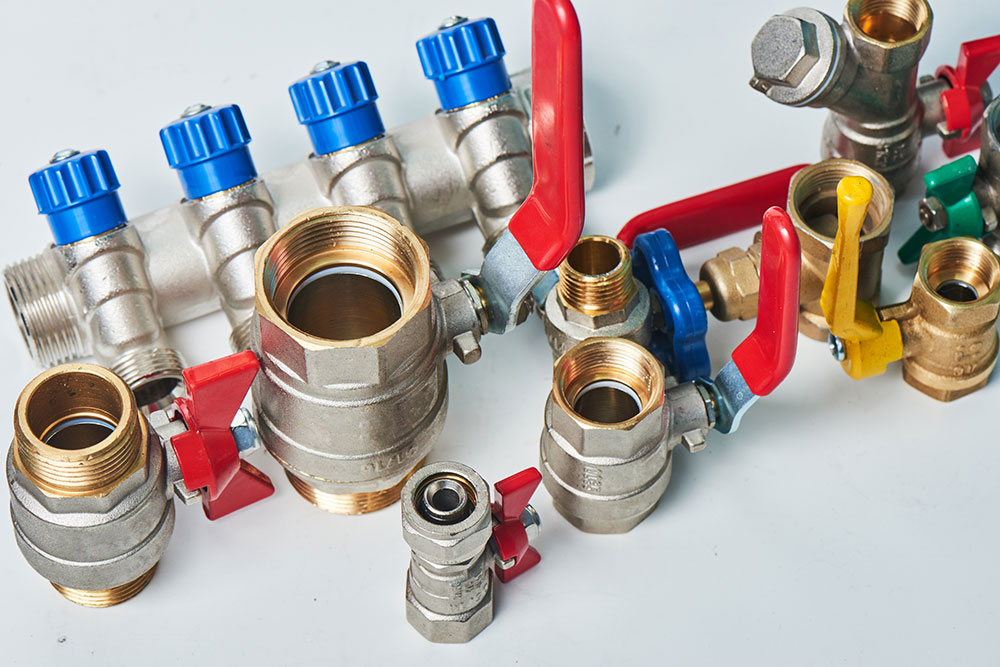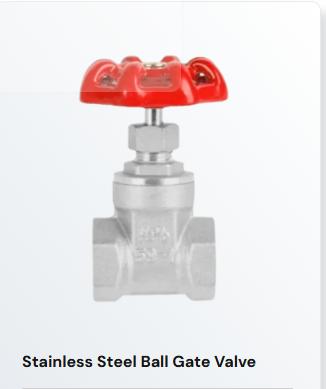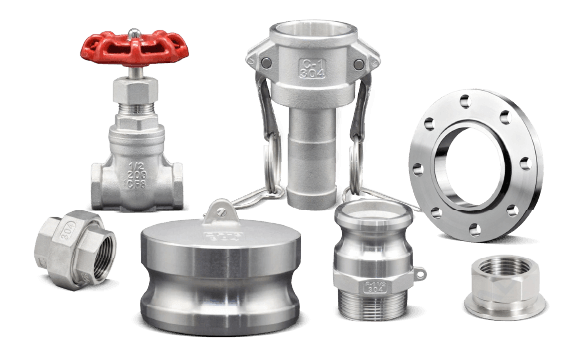

The importance of reliable valves in water treatment is to control and regulate the flow of fluid. Stainless steel valves for water are of different designs, sizes, and uses, varying in material grade. Understanding the key differences between various types of valves helps in selecting the right one for your application.
The difference between a stainless steel gate valve and a ball valve lies in their opening and closing mechanisms. A gate valve uses a vertical sliding disk to achieve shut-off. A ball valve uses an internal rotating ball with a bore that aligns with the pipe to allow or close flow.
Stainless steel is a non-porous, corrosion-resistant, and durable material for industrial valves. Both stainless steel gate valves and ball valves are applicable in numerous industries that use fluid or gas. Learn more about the differences and find the best valve for water treatment.
In general, a stainless-steel valve is any industrial valve that uses stainless steel in its construction. Stainless steel advantages in the construction of valves include its durability, non-corrosiveness, and ease of cleaning. You should know that there are various grades of stainless steel and varying capabilities.

A gate valve is a type of linear motion water treatment valve that allows or restricts the flow of fluid within a system. Its primary use is to open or shut the flow of water completely.
Gate valves work by raising a vertical disc that allows a full bore when in the open position. To shut off, you need to lower the gate by rotating a wheel or a lever attached to a stem. Common types of gate valves are:
Gate valves are standard in older plumbing systems and applications that do not require frequent shut-offs. They are ideal for large water supply lines due to their straight flow path and minimal flow restriction.
They are also the preferred valves for slurries and viscous fluids because they are easier to clean and maintain. You’ll find gate valves in piping that uses high pressure and high temperature.
Stainless steel gate valves benefit in water treatment systems include minimal pressure drops and are suitable for infrequent on/off service.
The main limitations of gate valves are their slow operation and lack of ideal throttling capabilities.

A stainless steel ball valve is a device for controlling flow by opening or closing a line. It uses a hollow pivoting sphere that rotates 90 degrees for opening and aligns the bore with the pipe. The rotary ball on the closure aligns the bore across the pipe, restricting the flow of fluid.
Operating a ball valve is simple and requires a single 90-degree turn of the handle. The handle also helps to indicate the condition. If the handle is perpendicular to the pipe, the valve is closed; when parallel to the pipe, it’s in its open position.
Ball valves are the best valves for water filtration and pumping stations. They do a quick job of isolating sections during routine maintenance, thus reducing downtime.
The rapid rotation of ball valves makes them useful in emergencies, when fast shut-off is needed to prevent further flow. The straight flow path in a ball valve also minimises pressure loss
The main benefits of ball valves in water treatment are:
However, ball valves also have limitations that include:
Although the primary function of steel gate valves and ball valves is to open or shut off flow, they have some notable differences. Here is a side-by-side comparison of stainless steel gate valves vs ball valves.


The main difference between stainless steel gate valves and ball valves is their structural design and speed of operation. In terms of shape and design, a stainless steel gate valve uses a disc ( or gate) that moves vertically as you turn the handle.
A ball valve, in contrast, is made up of a sphere (the “ball”) that has a cylindrical hole with the same diameter as the pipe. On rotating the handle, the ball aligns the bore parallel to the pipe to open or across the pipe to close.
A gate valve requires multiple turns of the wheel to raise or lower the internal gate. Ball valves open or close instantly using a single quarter turn.
The lifespan of a gate valve vs. a ball valve depends on the working conditions (pressure, temperature, medium) and usage frequency. A gate valve has more movable parts and uses several turns in operation, which contributes to wear and tear. The internal disc is also prone to damage if you use the gate valve for throttling.
Ball valves may have a longer lifespan than gate valves. They have a less complex design and fewer movable parts. The use of a quarter turn in operation also reduces wear and tear of the internal parts. Nevertheless, if you strictly use a stainless steel gate valve in the fully open or closed position in the right conditions, it will serve for a long time and ensure the durability of the system.
Manual stainless steel gate valves are generally cheaper. They come in a simple design that is economical for a basic open/close application. Gate valves are also less expensive for large diameters than ball valves.
Stainless steel ball valves of similar specifications have a slightly higher price than gate valves. The valves require precise machining and manufacturing, which raises the cost. Ball valves also use more complex parts.
Due to the differences in design, the maintenance of stainless steel gate valves and ball valves is different. Gate valves have a more demanding maintenance routine because they have more movable parts. They may require frequent lubrication and inspection of the packing for leakages.
Cleaning a gate valve is also somewhat complicated because its cavity can hold debris, which can cause contamination. Typically, cleaning a ball valve is easy; sometimes, you only need to open it for self-flushing.
The material making an industrial valve contributes to its wear and tear in a corrosive environment. Stainless steel valves have a protective chromium oxide layer that reduces corrosion and rust.
So, both the stainless steel gate valves and ball valves are ideal in a corrosive environment. However, you need to choose the correct valve depending on the medium, pressure, frequency of use, and the need for rapid opening or closing.
Stainless gate valves are ideal for applications that do not require frequent shut-offs. If you need to control the flow of fluid in a direction infrequently, a gate valve can serve you economically.
Stainless steel gate valves vary in size and connection type. The pipe size, content, pressure, and temperature are key considerations when selecting a valve. Water treatment valve types made of stainless steel are ideal for large diameter pipelines with infrequent flow adjustments.
Understanding the difference between stainless steel gate valve vs ball valves is critical. Each device has its capabilities. A stainless ball valve will help you shut off a spillage using an easy 90-degree turn.
Stainless steel continues to produce the best valves for water filtration. Water treatment systems require the use of multiple types of valves. Ball valves are superior to gate valves in the following scenarios:
Fluid viscosity contributes when choosing a valve. A ball valve is ideal in both clean and wastewater applications. You can use a ball valve in clean or wastewater delivery. Ball valves enable fast loading and offloading. Gate valves are ideal for large main pipes that require infrequent shut-offs/openings.
Stainless steel gate valves are not ideal for throttling services. The gate or disc causes turbulent and inefficient flow control. There are better valves for continuously variable flow regulations. You need to use a stainless-steel ball valve or other designs, like globe or butterfly valves.
For larger pipes, gate valves have a fairer price. The devices are tall and require additional overhead space above the pipe.
Determining between a stainless gate valve and a ball valve depends on which is best for your water treatment. Consider factors like temperature, pressure, and contamination level in terms of corrosiveness and physical debris.
If there is a need for frequent maintenance and cleaning routines, a stainless steel ball valve will serve better. A gate valve may require regular lubrication, and it can also get damaged by cavitation.
Financial constraints may lead you to select an improper device. However, you should also look at the total cost of ownership. Are you willing to incur frequent costs of repair and replacements? Stainless steel ball valves and gate valves are ideal for applications in a variety of fields.
Summary of comparison between ball valves and gate valves
| Factor | Ball Valve | Gate Valve |
| Operating Principles | 90-degree turn for quick operation | Multi-turn, slower operation |
| Design and Structure | Rotary motion, compact design | Linear motion requires more space |
| Operation Speed | Quick operation, ideal for fast shut-off | Slower, less suited for rapid shut-off |
| Sealing | Metal-to-metal or soft seat | Soft or hard seat, tight seal |
| Sealing Performance | Superior sealing, reduced leakage risk | Effective, but more prone to wear and leakage |
| Materials and Durability | Robust design, longer lifespan, resistant to wear | Wear-prone over time, but effective initially |
| Applications | Suitable for frequent operation | Best for infrequent operation |
| Cost | Generally higher upfront cost, but more cost-effective long-term | Less expensive initially, but higher maintenance costs |
| Automation Support | Easy to automate | Less suitable for automation |
| Multi-Port Configuration | Supports multi-port | Limited to two-way designs |
The provision of water through a piping system falls under specific regulations. International health bodies, Nations, and Municipalities have established standards for the quality and delivery systems of sustainable and safe domestic water.
There are regulations regarding the delivery of domestic, agricultural, and industrial water, the disposal of wastewater, and the recycling of wastewater. Manufacturers of industrial valves ensure they follow the laid-down standards when producing industrial valves. Some of the bodies that ensure stainless steel valve manufacturers adhere to the regulations and standards include:
Stainless steel valve advantages include its non-porous material and resistance to corrosion. Gate valves and ball valves made of stainless steel have a longer lifespan, and because of the material, they have approval in both the food and chemical industries.
There is no superiority between stainless steel gate valves and ball valves. Both are ideal industrial valves for use under different conditions in a water system. However, you need to consult a professional to determine the correct device for your application.
Ball valves are ideal for frequent shut-off and opening needs. Gate valves, on the other hand, are better suited for situations requiring irregular flow adjustments. They also serve you better when working with viscous liquids, such as wastewater treatments.
Stainless ball valves are easier to clean, require minimal maintenance, and may last longer. They have fewer movable parts than gate valves, which reduces their wear and tear. You can consult us for a guide on the type of stainless steel valve that is suitable for your application.
The durability of an industrial valve depends on the material, medium, pressure, and temperature, among others. However, a ball valve can outlive a gate valve in corrosive water.
Stainless steel gate valves or ball valves are cost-effective and have a longer lifespan than those made of other metallic materials.
Both can be automated. But ball valves are easier to automate because they use a single turn.
For a high-pressure water treatment system, you need to choose the valve type depending on the application. A ball valve is ideal for rapid closing or opening.
You need to consult with a professional to determine the correct valve according to your wastewater or clean water system.
